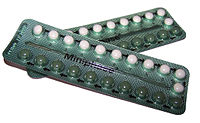
Photo from wikipedia
Background The sexual and reproductive health (SRH) needs of adolescents remain largely unmet. For instance, over 20 million female adolescents in need of, a modern contraceptive method are not using… Click to show full abstract
Background The sexual and reproductive health (SRH) needs of adolescents remain largely unmet. For instance, over 20 million female adolescents in need of, a modern contraceptive method are not using any. This study determined the factors associated with utilization of modern contraceptives among female adolescents in Uganda. Methods A cross sectional study was conducted using the Uganda Demographic and Health Survey (UDHS) 2016 data of 4, 264 adolescents aged 15 to 19 years. Multistage stratified sampling was used to select study participants. Multivariable logistic regression was used to determine the factors associated with modern contraceptive utilization. All our analyses were done using SPSS version 25. Results The prevalence of modern contraceptive utilization among female adolescents was 9.4% (401/4264: (95% CI: 8.6–10.3). The odds of contraceptive utilisation were 1.6 times (AOR = 1.60; 95% CI: 1.09–2.34) higher among married adolescents compared to unmarried adolescents. Adolescents whose age at first birth was less than 15 years (AOR = 2.01; 95% CI: 1.01–3.99) were twice more likely to utilize a modern contraceptive compared to those whose age at first birth was above 15 years. Women belonging to the Central region (AOR = 1.93; 95% CI: 1.01–3.69) and those in the middle wealth quintile (AOR = 1.91; 95% CI: 1.06–3.46) were 93% and 91% more likely to utilize a modern contraceptive compared to those in the Northern region and those in the poorest wealth index respectively. Conclusion The prevalence of modern contraceptive utilization was 9.4%. The findings show the need for designing targeted interventions due to differences in adolescents according to their wealth index, regions and marital status.
Journal Title: BMC Women's Health
Year Published: 2021
Link to full text (if available)
Share on Social Media: Sign Up to like & get
recommendations!